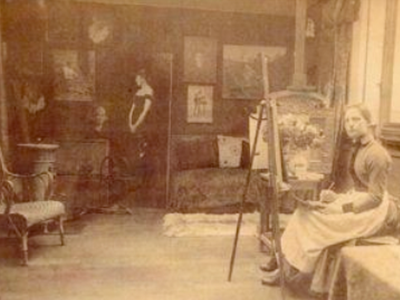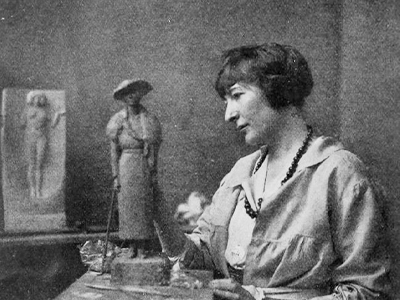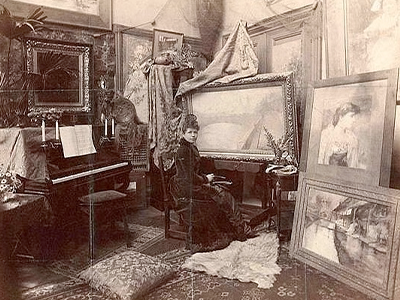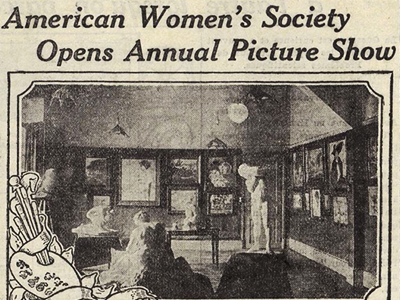American Woman's Art Association, 1893 – 1914
Founded sometime in 1892, the primary aim of the American Woman’s Art Association (AWAA) was to organize exhibitions for American women artists in Paris. Their first show opened before the Girls' Art Club even existed, on March 1, 1893, at 19 rue Vavin, the American Social Reading Rooms that had been founded by Rev. and Mrs. W.W. Newell. The AWAA, then described in the European edition of The New York Herald as the "American Women's Art Club of Paris," was a new organization "formed for the purpose of bringing before the public the work of American women studying or working here." Though the Herald did not name the founders of this new group, it listed the exhibition jury: Elizabeth Nourse, Kathleen Greatorex, and Ellen Kendall Baker (February 19, 1893, 5). On March 4, 1893, the Herald published a brief review of the "modest little show," encouraging all Americans in Paris to visit and admire the "collective work of their fair countrywomen" (3).
Once the American Girls’ Art Club officially opened at 4 rue de Chevreuse in the fall of 1893, it became the natural home of the AWAA’s exhibitions and served as the association’s headquarters. AWAA shows at the Club enabled up-and-coming women artists to publicly display their paintings, sculptures, drawings, miniatures, and engravings, often for the first time. Though a number of women artists enjoyed successful careers and were regulars at the prestigious Paris Salons, many others depended on these exhibitions as the sole opportunities to share and sell their work.
The first public exhibition at the American Girls' Art Club debuted in December of that same year. It was sponsored by the American Woman’s Art Association (AWAA) and featured works by 60 women artists and students, many of whom were residents at 4 rue de Chevreuse. The exhibition was well-attended by members of the American colony, French critics, and atelier masters; the overwhelming success of this show quickly transformed the event into a highly-anticipated annual tradition.
At first, it was a somewhat rocky start for the AWAA, an organization uniquely run by women artists for women artists. Its inauspicious beginnings were described in January 1900 for Harper's Bazaar:
The American Woman’s Art Association has been so far held together by a somewhat fragile thread. It has no stable organization, it has no permanent officers, and it has no fixed place of exhibit. Every new season the surviving members left over from the year before have met and elected new officers, and there has been another exhibition. But now the utility of such an association has come to be so widely recognized that an effort is being made to arrange for having the officers elected in the summer for the following year. In this way there will be a perpetual chain [...] (De Forest 33).
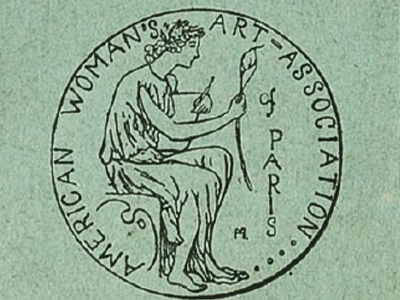


Despite early questions about the structure and leadership of the AWAA, the organization persisted, successfully mounting almost 30 exhibitions over its twenty-year existence. The shows were usually favorably reviewed by the French and American press and the AWAA eventually implemented several committees to ensure that each exhibition would run smoothly.
In 1904, there was a Hanging Committee, which included Alice H. Barri, Alice Schille, and Anna Lynch. Alice Jones and Edna Hays Vosburgh served on the Invitation Committee, while the Reception Committee was composed of Marion Powers and Ella Hergesheimer.
By 1910, these committees had evolved and grown in number. The all-important Hanging Committee, which decided where each work of art would be displayed within the exhibition, featured Mary Fraser Wesselhoeft, Florence Lundborg, and Kathleen McEnery. A new committee, the Printing Committee, likely in charge of printing the exhibition program, had three members: Zelda Shanfield, M. Anna Watson, and Alice Morgan Wright. The Receiving Committee, which literally received all the works of art from participating artists before transferring them to the Hanging Committee to be mounted, was comprised of Mrs. E. Blackburn, Alice Herthel, and Maud Murray. Finally, the Reception Committee, the largest group, who were charged with planning the opening festivities, included: Helen Goodwin, Adeline Cheron, Mary Lyttleton Wyatt, Florence Lucius, Alice McClure, Frances Trumbull Lea, and Constance Bigelow.
In addition to the grand annual exhibition, the AWAA would eventually sponsor 2-3 more shows at the Girls’ Art Club each year, including ones dedicated exclusively to sculpture and to drawings/miniatures/etchings. Though archival records of the AWAA are unfortunately scarce, the legacy of this organization and its importance to American women artists in Paris cannot be overstated.
The American Girls' Art Club was forced to close in 1914 because of WWI and many American women returned to the United States. Though we can’t say for sure, the AWAA appears to have dissolved at this time. A number of American artists remained in Paris to help the French and the Allies. After the war ended, art students returned to Europe in large numbers but exhibitions were no longer a constant feature of life at 4 rue de Chevreuse as the property had been transformed into the University Women’s Club. There is no doubt that the AWAA would have continued to grow and evolve if not for the disruption of the war and the changes it wrought in the 20th-century world.
For details about the hundreds of artists who exhibited with the AWAA between 1893 and 1914, see Artist Index.
Consult the sources for the American Women's Art Association
